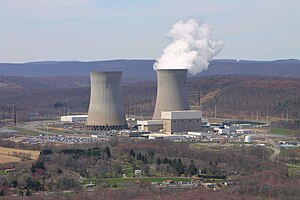In a surprise order last Friday (Nov. 1), the Federal Energy Regulatory Commission rejected a plan advanced by the PJM Interconnection for an Amazon data center to co-locate next to Talen Energy’s 2,500-MW two-unit Susquehanna nuclear plant near Wilkes-Barre, Pa.

Under the failed proposal, Amazon would take up to 480-MW of power directly from the plant, rather than getting power from the PJM regional transmission agency’s high-voltage, interstate transmission grid.
The “notational order” (it was not discussed as a group at a regular FERC public meeting to avoid triggering the 1976 Government in the Sunshine Act) came the same day the agency held a technical conference on co-location of loads with generators. That topic is getting a lot of attention as electric-intensive data centers pose at least a theoretical challenge to the U.S. electrical system. Neither the order nor the technical conference produces much clarity about the gnarly topic.
The vote on the order reflects the problems in unravelling the complexities of co-location. The vote on the order rejecting the PJM proposal was 2-1. Republican commissioners Mark Christie and Lindsay See were the majority. Chairman Willie Phillips, a Democrat, dissented. Neither commissioners David Rosner nor Judy Change, both Democratic appointees, participated.
In his dissent, Phillips said the rejection of the PJM proposal “is a step backward for both electric reliability and national security. The amended Interconnection Service Agreement…represents a ‘first of its kind’ co-located load configuration that presents precisely the sort of specific reliability concerns, novel legal issues, and other unique factors that should have justified the filing of a non-conforming interconnection agreement
Christie said, “Were we to approve this proposal at this time, as the dissent advocates, we would be setting a precedent that would be used to justify identical or similar arrangements in future cases.” He said, “PJM has failed to meet its burden of proof on this record. I emphasize that PJM’s filing is rejected without prejudice. Speaking for myself, I have an open mind about the many serious issues pertinent not just to this particular proposal, but also to the issues that may be relevant to other co-location proposals. The specific co-location arrangement proposed here may make sense and be acceptable under the Federal Power Act, but on this record that claim simply has not been proven.”
Initially in June 2024 and amended in September, PJM filed an amendment to its Interconnection Service Agreement to permit the co-location of the new load. Two major utilities with a large PJM footprint, Exelon and AEP, immediately protested. As the FERC order states, they argued “that the PJM capacity markets will suffer as capacity resources exit to serve load that uses and benefits from, but does not pay for, the system and that replacement capacity will take years to develop.”
Exelon and AEP said “that using a PJM capacity resource as a back-up resource is ‘by any fair assessment’ relying on PJM resources…because the Co-Located Load receives power from Susquehanna, and Susquehanna receives power from the transmission system.” They added that “nuclear plants cannot operate without electricity and cannot be islanded from the system.” They argued that the resulting cost shifting could cost them “as much as $140 million per year.” Susquehanna disputed that figure.
PJM’s Market Monitor also opposed the grid operator’s co-location plan, arguing that it “would provide unique and special treatment for a specific type of load and a specific type of power plant and would set a precedent for significant changes to the PJM markets that will impose costs on other market participants.” The Market Monitor added that “the core benefit to the Co-Located Load is avoiding state and federal regulation and the associated costs, such as paying distribution charges and transmission charges.”
Pennsylvania Gov. Josh Shapiro asked FERC the assure that any action it takes “allows Pennsylvania to retain its ability through state policy decisions to continue serving as a leader for these issues.”
In an extended Tweet, Travis Kavulla, former Montana utility regulator and currently vice president for regulation at independent power generator NRGenergy, commented, “Traditionally, this would’ve been a noncontroversial item. Yet, utilities (ironically, not even the one concerned with this particular service territory) objected, because they see it as a threat to their endless gatekeeping of every single thing that happens on the grid.”
Kavulla added, “The result is weirdly fractured: 2 new commissioners not participating, Christie, Commissioner Lindsey See approving the order over Chair Phillips’s dissent. Not often you see anything like that.” He said that Phillips “definitely has the better position here. The big issues of ‘data center meets grid’ need to be addressed, but I don’t see how this docket genuinely raises any of them. FERC’s reasoning on this order, meanwhile, is tepid: Kick the can material.”
Reporting on FERC’s co-location technical conference on the same day as the PJM order, Power Engineering magazine’s headline also provides a useful summary of the state of play: “No quick fixes on data center-generator co-location issue.”
–Kennedy Maize
The Quad Report
To comment:
kenmaize@gmail.com



